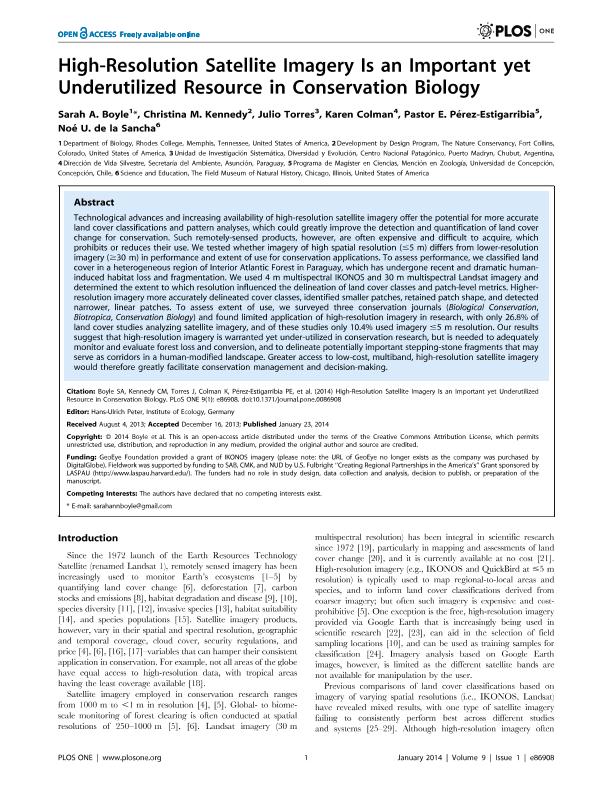Artículo
High-resolution satellite imagery is an important yet underutilized resource in conservation biology
Boyle, Sarah A.; Kennedy, Christina M.; Torres Monges, Julio Cesar ; Colman, Karen; Pérez Estigarribia, Pastor E.; de la Sancha, Noé U.
; Colman, Karen; Pérez Estigarribia, Pastor E.; de la Sancha, Noé U.
 ; Colman, Karen; Pérez Estigarribia, Pastor E.; de la Sancha, Noé U.
; Colman, Karen; Pérez Estigarribia, Pastor E.; de la Sancha, Noé U.
Fecha de publicación:
01/2014
Editorial:
Public Library of Science
Revista:
Plos One
ISSN:
1932-6203
Idioma:
Inglés
Tipo de recurso:
Artículo publicado
Clasificación temática:
Resumen
Technological advances and increasing availability of high-resolution satellite imagery offer the potential for more accurate land cover classifications and pattern analyses, which could greatly improve the detection and quantification of land cover change for conservation. Such remotely-sensed products, however, are often expensive and difficult to acquire, which prohibits or reduces their use. We tested whether imagery of high spatial resolution (≤5 m) differs from lower-resolution imagery (≥30 m) in performance and extent of use for conservation applications. To assess performance, we classified land cover in a heterogeneous region of Interior Atlantic Forest in Paraguay, which has undergone recent and dramatic human-induced habitat loss and fragmentation. We used 4 m multispectral IKONOS and 30 m multispectral Landsat imagery and determined the extent to which resolution influenced the delineation of land cover classes and patch-level metrics. Higher-resolution imagery more accurately delineated cover classes, identified smaller patches, retained patch shape, and detected narrower, linear patches. To assess extent of use, we surveyed three conservation journals (Biological Conservation, Biotropica, Conservation Biology) and found limited application of high-resolution imagery in research, with only 26.8% of land cover studies analyzing satellite imagery, and of these studies only 10.4% used imagery ≤5 m resolution. Our results suggest that high-resolution imagery is warranted yet under-utilized in conservation research, but is needed to adequately monitor and evaluate forest loss and conversion, and to delineate potentially important stepping-stone fragments that may serve as corridors in a human-modified landscape. Greater access to low-cost, multiband, high-resolution satellite imagery would therefore greatly facilitate conservation management and decision-making.
Palabras clave:
Imagery
,
High Resolution
,
Atlantic Forest
,
Consevation
Archivos asociados
Licencia
Identificadores
Colecciones
Articulos(CCT-CENPAT)
Articulos de CTRO.CIENTIFICO TECNOL.CONICET - CENPAT
Articulos de CTRO.CIENTIFICO TECNOL.CONICET - CENPAT
Citación
Boyle, Sarah A.; Kennedy, Christina M.; Torres Monges, Julio Cesar; Colman, Karen; Pérez Estigarribia, Pastor E.; et al.; High-resolution satellite imagery is an important yet underutilized resource in conservation biology; Public Library of Science; Plos One; 9; 1; 1-2014; e86908
Compartir
Altmétricas



